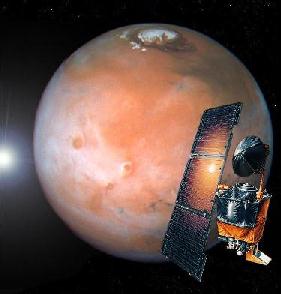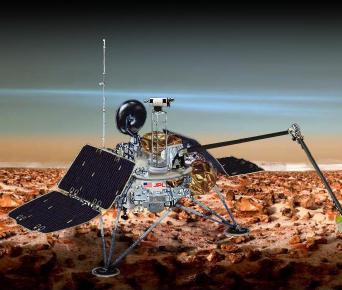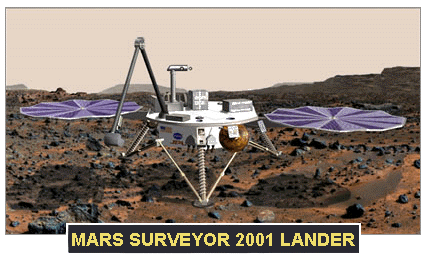
The three primary goals of future Mars explorations are

The Mars Climate Orbiter will arrive at Mars in September 1999. It will study the distribution of water on Mars. An infrared radiometer will scan the atmosphere to profile its temperature, dust and water-vapor content, and clouds. It will take color pictures with a resolution or 40 meters and produce daily global images of the Martian atmosphere.

The Mars Polar Lander will land near the edge of the Martian south polar cap. As it descends towards touchdown, it will take a series of pictures to see what the terrain near the ice cap is like. On Mars, the lander will spend 4 months studying the climate and geology of Mars. A robotic arm will dig half a meter or a meter into the surface and examine 100,000 years of the Martian geologic record. The lander will also have a microphone to allow us to listen to the sounds of Mars.
Before the probe enters the atmosphere, it will deploy two "microprobes." Two basketball-sized aeroshells will crash onto the Martian surface at a velocity of about 200 meters per second. Shattering on impact, each aeroshell will release a miniature two-piece science probe that will punch into the soil to a depth of up to 2 meters. The microprobes' primary science goal is to determine if water ice is present in the Martian subsurface - an important clue in the puzzle of whether life exists, or ever existed, on Mars. The tiny science stations will also measure soil temperature and monitor local Martian weather. The microprobes will operate for just about 50 hours. They are expected to land about 200 km from the landing site of the Mars Polar Lander.


The Mars Surveyor 2001 Orbiter is scheduled for launch on April 18, 2001. It will arrive at Mars on Oct. 27, 2001, if launched on schedule. The 2001 Orbiter will be the first to use the atmosphere of Mars to slow down and directly capture a spacecraft into orbit in one step, using a technique called aerocapture. It will then reach a circular mapping orbit within about 1 week after arrival. The Orbiter will carry 2 main science instruments, the Thermal Emission Imaging System (THEMIS) and the Gamma Ray Spectrometer (GRS). THEMIS will map the mineralogy and morphology of the Martian surface using a high resolution camera and a thermal infrared imaging spectrometer. The GRS will achieve global mapping of the elemental composition of the surface and the abundance of hydrogen in the shallow subsurface. The gamma ray spectrometer was inherited from the lost Mars Observer mission. The 2001 Orbiter will also support communication with the Lander and Rover scheduled to arrive on Jan. 22, 2002.

The Mars Surveyor 2001 Lander is scheduled for launch on April 10, 2001. It will land on Mars on Jan. 22, 2002, if launched on schedule. The 2001 Lander will carry an imager to take pictures of the surrounding terrain during its' rocket-assisted descent to the surface. The descent imaging camera will provide images of the landing site for geologic analyses, and will aid planning for initial operations and traverses by the rover. The 2001 Lander will also be a platform for instruments and technology experiments designed to provide key insights to decisions regarding successful and cost-effective human missions to Mars. Hardware on the Lander will be used for an in-situ demonstration test of rocket propellant production using gases in the Martian atmosphere. Other equipment will characterize the Martian soil properties and surface radiation environment.

As part of the 2001 mission redesign, the plans for the 2001 Rover have changed significantly. Current plans are to send the Marie Curie rover to Mars on the 2001 lander. This rover is very similar to the Pathfinder Sojourner Rover.